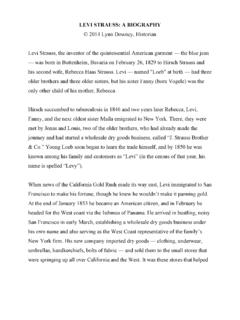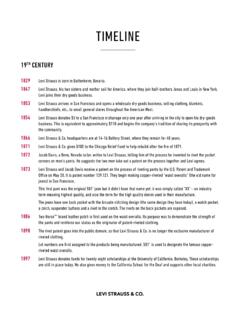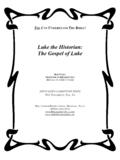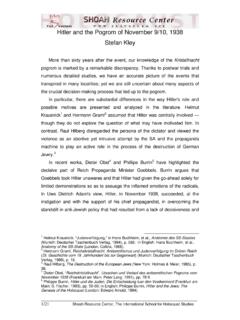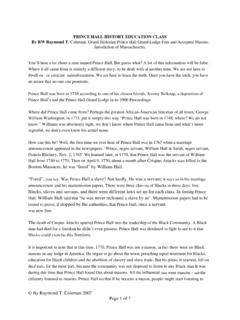Transcription of A SHORT HISTORY OF DENIM ©2014 Lynn Downey …
1 A SHORT HISTORY OF DENIM 2014 Lynn Downey Levi Strauss & Co. historian DENIM is more than just a cotton fabric; it inspires strong opinions within the hearts of historians, designers, teenagers, movie stars, reporters and writers. Interest bordering on passion can be found among textile and costume historians today, especially in the debate over the true origins of DENIM . These experts have put decades of work into their research; here are summarized the prevailing opinions about the birth of DENIM , followed by a discussion of the way Levi Strauss & Co. has helped to contribute to DENIM s movement around the world. In 1969 a writer for American Fabrics magazine declared, DENIM is one of the world s oldest fabrics, yet it remains eternally young. If continuous use of and interest in an item makes it eternally young then DENIM certainly qualifies. From the 17th century to the present, DENIM has been woven, used and discarded; made into upholstery, pants and awnings; found in museums, attics, antique stores and archaeological digs; worn as the fabric of hard honest work, and as the expression of angry rebellion; used for the sails of Columbus ships in legend; and worn by American cowboys in fact.
2 Legend and fact are also interwoven when scholars discuss the origin of the name DENIM itself. Most reference books say that DENIM is an English corruption of the French serge de Nimes; a serge fabric from the town of Nimes in France. However, some scholars have begun to question this tradition. There are a few schools of thought with regard to the derivation of the word DENIM . Pascale Gorguet-Ballesteros, of the Musee de la Mode et du Costume in Paris, has done some interesting research on both of these issues. A fabric called serge de Nimes, was known in France prior to the 17th century. At the same time, there was also a fabric known in France as nim. Both fabrics were composed partly of wool. Serge de Nimes was also known in England before the end of the 17th century. The question then arises: is this fabric imported from France or is it an English fabric bearing the same name?
3 According to Ms. Gorguet-Ballesteros, fabrics which were named for a certain geographic location were often also made elsewhere; the name was used to lend a certain cachet to the fabric when it was offered for sale. Therefore a serge de Nimes purchased in England was very likely also made in England, and not in Nimes, France. There still remains the question of how the word DENIM is popularly thought to be descended from the word serge de Nimes. Serge de Nimes was made of silk and wool, but DENIM has always been made of cotton. What we have here again, I think, is a relation between fabrics that is in name only, though both fabrics are a twill weave. Is the real origin of the word DENIM serge de nim, meaning a fabric that resembled the part-wool fabric called nim? Was serge de Nimes more well-known, and was this word mis-translated when it crossed the English Channel? Or, did British merchants decide to give a zippy French name to an English fabric to give it a bit more cachet?
4 It s likely we will never really know. Then, to confuse things even more, there also existed, at this same time, another fabric known as jean. Research on this textile indicates that it was a fustian - a cotton, linen and/or wool blend - and that the fustian of Genoa, Italy was called jean; here we do see evidence of a fabric being named from a place of origin. It was apparently quite popular, and imported into England in large quantities during the 16th century. By the end of this period jean was being produced in Lancashire. By the 18th century jean cloth was made completely of cotton, and used to make men s clothing, valued especially for its property of durability even after many washings. DENIM s popularity was also on the rise. It was stronger and more expensive than jean, and though the two fabrics were very similar in other ways, they did have one major difference: DENIM was made of one colored thread and one white thread; jean was woven of two threads of the same color.
5 Moving across the Atlantic, we find American textile mills starting on a small scale at this same time, the late 18th century, mostly as a way to become independent from foreign producers (mainly the English). From the very beginning, cotton fabrics were an important component of their product line. A factory in the state of Massachusetts wove both DENIM and jean. President George Washington toured this mill in 1789 and was shown the machinery which wove DENIM , which had both warp and fill of cotton. One of the first printed references to the word DENIM in the United States was seen in this same year: a Rhode Island newspaper reported on the local production of DENIM (among other fabrics). The book The Weavers Draft Book and Clothiers Assistant, published in 1792, contains technical sketches of the weaving methods for a variety of denims. In 1864, an East Coast wholesale house advertised that it carried 10 different kinds of DENIM , including New Creek Blues and Madison River Browns.
6 (They sound rather contemporary, don t they? Another example of DENIM appearing eternally young. ) Webster s Dictionary of the same year contained the word DENIM , referring to it as a coarse cotton drilling used for overalls, etc. Research shows that jean and DENIM were two very different fabrics in 19th century America. They also differed in how they were used. In 1849 a New York clothing manufacturer advertised topcoats, vests or SHORT jackets in chestnut, olive, black, white and blue jean. Fine trousers were offered in blue jean; overalls and trousers made for work were offered in blue and fancy DENIM . Other American advertisements show working men wearing clothing that illustrates this difference in usage between jean and DENIM . Mechanics and painters wore overalls made of blue DENIM ; working men in general (including those not engaged in manual labor) wore more tailored trousers made of jean.
7 DENIM , then, seems to have been reserved for work clothes, when both durability and comfort were needed. Jean was a workwear fabric in general, without the added benefits of DENIM as I just mentioned. In Staple Cotton Fabrics by John Hoye, published in 1942, jean is listed as a cotton serge with warp and woof of the same color, used for overalls, work and sport shirts, doctors and nurses uniforms and as linings for boots and shoes. Of DENIM , Hoye says, The most important fabric of the work-clothing group is DENIM . Denims are strong and serviceable; they are particularly strong in the warp direction, where the fabric is subjected to greater wear than the filling. Twenty years after this was written, the magazine American Fabrics ran an article which stated, If we were to use a human term to describe a textile we might say that DENIM is an honest fabric - substantial, forthright, and unpretentious.
8 So how did this utilitarian and unpretentious fabric become the stuff of legends that it is today? And how did pants made out of DENIM come to be called jeans, when they were not made out of the fabric called jean? One very important reason can be found in the life and work of a Bavarian-born businessman who made his way to Gold Rush San Francisco more than 150 years ago. Levi s jeans, of course, are named for the founder of the company that makes them. A lot of people over the years have thought that Levi Strauss & Co. was started by a Mr. Levi and a Mr. Strauss; or even by the French philosopher/anthropologist Claude Levi-Strauss. The truth is, the company was founded by a man born as Loeb Strauss in Bavaria in 1829. He, his mother and two sisters left Germany in 1848 and sailed to New York, where Loeb s half-brothers were in business selling wholesale dry goods (bolts of cloth, linens, clothing, etc.)
9 For a few years, young Loeb Strauss worked for his brothers, and in 1853 obtained his American citizenship. In that same year, he decided to make a new start and undertake the hazardous journey to San Francisco, a city enjoying the benefits of the recent Gold Rush. At age 23, Loeb either decided to go into the dry goods business for himself (perhaps thinking that the easiest way to make money during a Gold Rush was to sell supplies to miners), or he was sent there by his brothers, in order to open the West Coast branch of the family business. No matter what the reason, San Francisco was the kind of city where people went to reinvent themselves and their lives, and this proved to be true for Loeb, who changed his name to Levi sometime around 1850, - for which we should be grateful, or else today we would all be wearing Loeb s Jeans. We don t know how young Levi Strauss got his business off the ground; what his thinking was; if he travelled into the gold country in search of customers, because LS&CO.
10 Lost virtually all of its records, inventory, and photographs in the great San Francisco earthquake and fire of 1906. This has led to many problems for company officers, researchers, and certainly those interested in LS&CO. s HISTORY . Chief of these is digging up the true story of the invention of blue jeans, and separating popular myth from historical reality. For decades, the story ran like this: Levi Strauss arrived in San Francisco, and noticed that miners needed strong, sturdy pants. So he took some brown canvas from the stock of dry goods supplies he brought with him from New York, and had a tailor make a pair of pants. Later, he dyed the fabric blue, then switched to DENIM , which he imported from Nimes. He got the idea of adding metal rivets to the pants from a tailor in Reno, Nevada, and patented this process in 1873. Luckily, the company obtained copies of the patent papers for the riveting process a number of years ago so we know that Jacob Davis, the Nevada tailor, did come up with this idea and worked with Levi Strauss to manufacture riveted clothing.







